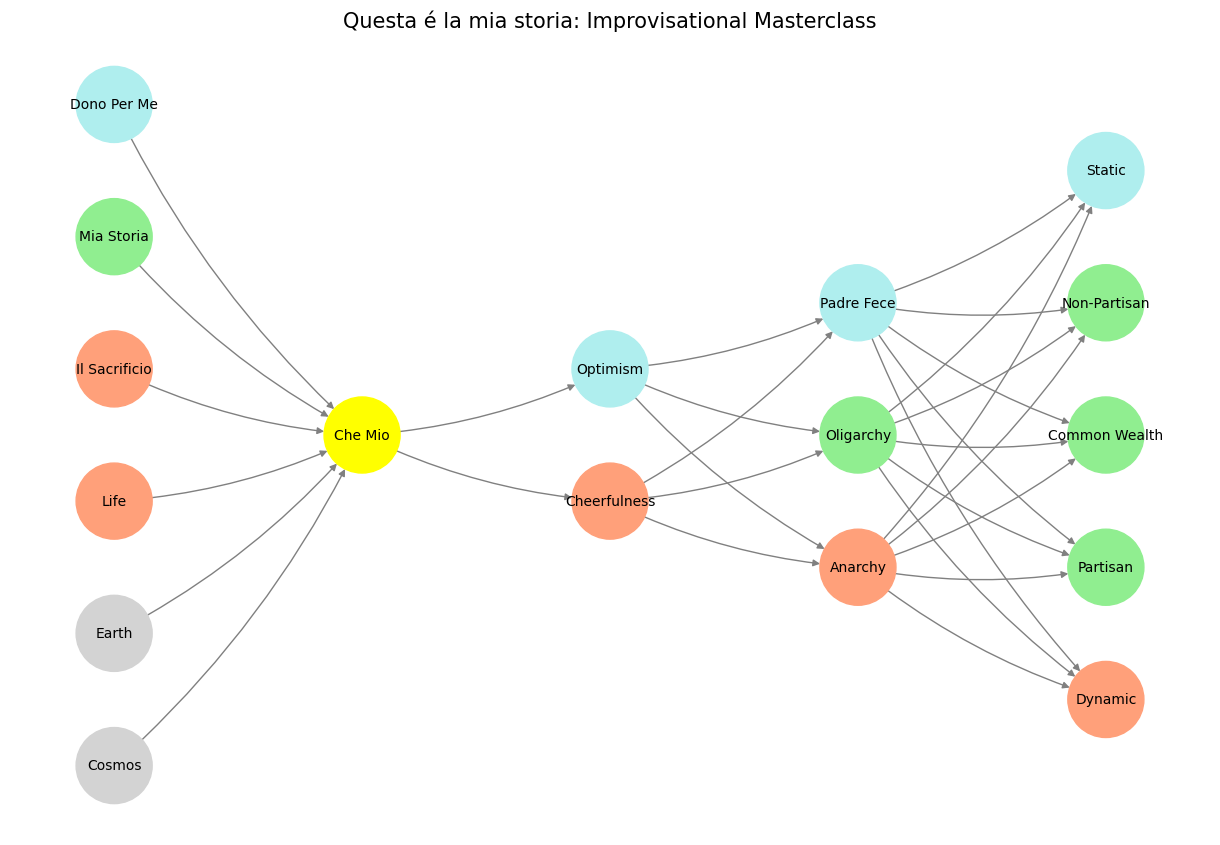Anchor ⚓️#
Can We Agree On The Objective Function to Optimize?#
The question of optimizing an objective function in a conceptual neural network is both provocative and essential. In the physical (output) layer of our network, we find mutually exclusive or competing nodes, reflecting humanity’s perennial struggle to prioritize values and reconcile tensions. The inclusion of nodes such as Dynamic, Static, Partisan, Non-Partisan, and Common Wealth suggests a deliberate choice to elevate the complexity of principal-agent theory, moving beyond simplistic binaries. This essay explores how this framework enables us to digest the competing narratives and forces that shape human civilization—from capitalism to mythology—while probing whether an overarching objective function can truly exist.
Questa è la mia storia.
Questo è il sacrificio.
Che mio padre fece.
Questo era il suo dono per me.
– Giosuè
The Italian phrasing not only reflects the film’s cultural roots but also preserves the lyrical rhythm of Giosuè’s tribute to his father’s profound love and sacrifice. It’s this lyrical rhythm that rejects any attempts at translating Italian opera or even our very own Commedia. 1 2 3
The Expansion of Principal-Agent Theory#
Traditional principal-agent theory, rooted in economics and organizational studies, frames relationships as a binary between the principal (goal-setter) and the agent (goal-executor). This simplicity works well in contained environments, such as a firm or a specific transaction, but it collapses under the weight of complex societal phenomena. Our framework introduces at least five distinct categories, broadening the aperture to accommodate the intricate interplay of competing incentives and objectives.
By recognizing this expanded matrix, we can begin to analyze ideologies and movements with a richer lens:
Capitalism vs. Marxism: These economic systems prioritize fundamentally different nodes—capitalism optimizes for profit and individual agency, while Marxism centers on collective welfare and equity. The tension arises from their irreconcilable objective functions, where one’s success often predicates the other’s failure.
Feminism vs. Patriarchy: The struggle for gender equity forces us to reconcile dynamic power shifts with static structures of historical privilege. These movements challenge entrenched hierarchies, emphasizing a generative approach to equality while navigating resistance from static systems.
Colonialism vs. Tribalism: Colonialism seeks to homogenize and exploit, often under the guise of progress, while tribalism clings to identity and rootedness. The clash of these nodes reveals the difficulty of optimizing for common wealth when cultural survival and economic hegemony pull in opposite directions.
Religion vs. Atheism: These nodes operate on different epistemological planes—faith-based versus empiricist. While religion optimizes for transcendental meaning, atheism centers on tangible, evidence-based reality. Yet both seek to answer the same existential questions, albeit through incompatible means.
Art vs. Algorithms: Art thrives on subjective interpretation and emotional resonance, while algorithms prioritize efficiency, predictability, and scalability. The rise of AI blurs these boundaries but raises new questions about whether optimization should favor human creativity or machine precision.
The Challenge of Mutually Exclusive Objectives#
At the heart of this network lies the realization that many of these nodes are mutually exclusive. Attempting to optimize one often necessitates trade-offs that diminish the efficacy or validity of another. For instance:
The push for dynamic innovation (e.g., capitalism’s entrepreneurial spirit) often undermines static traditions (e.g., cultural preservation).
Non-partisan cooperation can appear as appeasement in a partisan conflict, eroding trust on both sides.
Common wealth initiatives may demand redistribution that conflicts with individualistic pursuits, breeding resentment.
These tensions underscore the impossibility of a universal optimization function that satisfies all nodes simultaneously. Instead, the system relies on iterative rebalancing—an ongoing negotiation of priorities shaped by context, resources, and temporal constraints.
The Role of Generativity#
Generativity emerges as a critical layer for navigating these competing nodes. Systems of governance (anarchy, oligarchy, monarchy) and movements (feminism, tribalism, art) provide pathways for creation and adaptation. Generativity allows for experimentation within the network, fostering the emergence of hybrid solutions that address specific tensions without collapsing into dogmatism.
Consider the interplay between feminism and capitalism. The rise of feminist entrepreneurship demonstrates a generative response, blending the profit motive with equity goals. Similarly, the convergence of art and algorithms—as seen in AI-generated music and literature—creates new paradigms where optimization shifts from exclusivity to coexistence.
Toward a Provisional Objective Function#
If we cannot agree on a universal objective function, can we at least define provisional ones? The answer may lie in prioritizing adaptability and resilience over fixed goals. Rather than seeking to maximize any single node, we might aim to optimize for:
Equilibrium: Balancing competing forces to prevent systemic collapse.
Inclusivity: Ensuring that all nodes have a voice, even when their objectives clash.
Feedback Loops: Building mechanisms for constant recalibration based on evolving circumstances.
Generative Synergies: Identifying intersections where nodes can coexist and enhance one another.
This approach mirrors the logic of ecological systems, which thrive not through dominance but through diversity and interdependence.
Conclusion: A Call for Meta-Optimization#
The ultimate challenge is not to optimize for any single node but to design systems capable of meta-optimization—balancing, integrating, and evolving multiple objective functions. This requires humility, as no single ideology or framework holds all the answers. It also demands creativity, as new pathways must continually be forged to navigate uncharted terrain.
In this light, the neural network becomes more than a metaphor; it is a living model for how we think, act, and evolve. By embracing its complexity and contradictions, we can begin to craft a future where optimization serves not just efficiency but humanity itself.
Show code cell source
import numpy as np
import matplotlib.pyplot as plt
import networkx as nx
# Define the neural network structure
def define_layers():
return {
'World': ['Cosmos', 'Earth', 'Life', 'Il Sacrificio', 'Mia Storia', 'Dono Per Me'], # Divine: Cosmos-Earth; Red Queen: Life-Cost; Machine: Parallel-Time
'Perception': ['Che Mio'],
'Agency': ['Cheerfulness', 'Optimism'],
'Generativity': ['Anarchy', 'Oligarchy', 'Padre Fece'],
'Physicality': ['Dynamic', 'Partisan', 'Common Wealth', 'Non-Partisan', 'Static']
}
# Assign colors to nodes
def assign_colors(node, layer):
if node == 'Che Mio':
return 'yellow'
if layer == 'World' and node in [ 'Dono Per Me']:
return 'paleturquoise'
if layer == 'World' and node in [ 'Mia Storia']:
return 'lightgreen'
if layer == 'World' and node in [ 'Cosmos', 'Earth']:
return 'lightgray'
elif layer == 'Agency' and node == 'Optimism':
return 'paleturquoise'
elif layer == 'Generativity':
if node == 'Padre Fece':
return 'paleturquoise'
elif node == 'Oligarchy':
return 'lightgreen'
elif node == 'Anarchy':
return 'lightsalmon'
elif layer == 'Physicality':
if node == 'Static':
return 'paleturquoise'
elif node in ['Non-Partisan', 'Common Wealth', 'Partisan']:
return 'lightgreen'
elif node == 'Dynamic':
return 'lightsalmon'
return 'lightsalmon' # Default color
# Calculate positions for nodes
def calculate_positions(layer, center_x, offset):
layer_size = len(layer)
start_y = -(layer_size - 1) / 2 # Center the layer vertically
return [(center_x + offset, start_y + i) for i in range(layer_size)]
# Create and visualize the neural network graph
def visualize_nn():
layers = define_layers()
G = nx.DiGraph()
pos = {}
node_colors = []
center_x = 0 # Align nodes horizontally
# Add nodes and assign positions
for i, (layer_name, nodes) in enumerate(layers.items()):
y_positions = calculate_positions(nodes, center_x, offset=-len(layers) + i + 1)
for node, position in zip(nodes, y_positions):
G.add_node(node, layer=layer_name)
pos[node] = position
node_colors.append(assign_colors(node, layer_name))
# Add edges (without weights)
for layer_pair in [
('World', 'Perception'), ('Perception', 'Agency'), ('Agency', 'Generativity'), ('Generativity', 'Physicality')
]:
source_layer, target_layer = layer_pair
for source in layers[source_layer]:
for target in layers[target_layer]:
G.add_edge(source, target)
# Draw the graph
plt.figure(figsize=(12, 8))
nx.draw(
G, pos, with_labels=True, node_color=node_colors, edge_color='gray',
node_size=3000, font_size=10, connectionstyle="arc3,rad=0.1"
)
plt.title("Questa é la mia storia: Improvisational Masterclass", fontsize=15)
plt.show()
# Run the visualization
visualize_nn()


Fig. 3 How now, how now? What say the citizens? Now, by the holy mother of our Lord, The citizens are mum, say not a word.#

